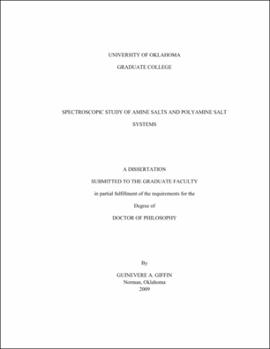| dc.contributor.advisor | Frech, Roger E | |
| dc.creator | Giffin, Guinevere Anne | |
| dc.date.accessioned | 2019-04-27T21:34:15Z | |
| dc.date.available | 2019-04-27T21:34:15Z | |
| dc.date.issued | 2009 | |
| dc.identifier | 99306187402042 | |
| dc.identifier.uri | https://hdl.handle.net/11244/319043 | |
| dc.description.abstract | Fundamental research is a necessary foundation for advanced technological development and application. Progress in improving application-based systems largely depends on understanding the nature of the system. A better understanding of the charge-containing species, their environment and the movement of protons through the system is necessary to improve proton-conducting membranes. This dissertation primarily focuses on investigating the moieties involved in charge transport in polymer electrolytes, in particular proton-containing species. | |
| dc.description.abstract | Vibrational spectroscopy is a particularly useful technique in interpreting the local environment present at heteroatom sites and the conformations along the backbone, and probing hydrogen bonding and coordination of salts. Connecting the vibrational spectrum of a crystal to the known structure of that crystal allows a direct correlation of the observed vibrational signatures to the structure. The power of combining crystal structures and vibrational spectra to interpret hydrogen bonding is strongly emphasized in this dissertation. | |
| dc.description.abstract | Polyamines, polyamine salts and model compounds of these polymeric systems are examined. Poly(alkylethylenimine)s are studied with respect to the effect of the sidechain length. Polymer electrolytes made from these polymers exhibited an unusual hysteresis effect with temperature cycling. Unlike PEO, these PEI-based systems show a decrease in ionic association. Cross-linked polyethylenimine hydrochloride is characterized using both vibrational and nuclear magnetic resonance spectroscopy to determine the degree of cross-linking and identify the vibrational signatures of the membrane moieties. Amine salt model compounds are studied in both the mid and near infrared regions. The band assignments of these amine model compounds are extended into a polymeric amine salt system. In the secondary amine salt systems, vibrational spectra were correlated with crystal structures and computational results to identify the vibrational modes of the protonated amine heteroatom sites. In a crystal containing several different heteroatom sites, the vibrational signatures of each type of site is identified by comparing portions of the asymmetric unit with simple model compounds. | |
| dc.description.abstract | The degree of intermolecular coupling within the unit cell of a crystal determines the nature of factor group vibrations and can have a dramatic effect on the rule of mutual exclusion. In DMEDA:HX crystals, the rule of mutual exclusion is obeyed to different degrees in various regions of the spectrum. This suggests that the degree of adherence to the rule of mutual exclusion can be correlated to the strength of the intermolecular coupling, particularly when the crystallographic inversion center does not lie on the asymmetric unit. | |
| dc.description.abstract | A significant portion of this dissertation focuses on hydrogen-bonded groups in amine salt systems. The findings reported here can be useful in interpreting the results seen in more complex polyamine and polyamine salt systems. In particular, the ability to identify heteroatom sites from their vibrations signatures is essential. These systems may have an important role as electrolytes in energy applications, specifically proton exchange membrane fuel cells. | |
| dc.format.extent | 139 pages | |
| dc.format.medium | application.pdf | |
| dc.language | en_US | |
| dc.relation.requires | Adobe Acrobat Reader | |
| dc.subject | Vibrational spectra | |
| dc.subject | Polyamines--Spectra | |
| dc.subject | Amines--Spectra | |
| dc.title | Spectroscopic Study of Amine Salts and Polyamine Salt Systems | |
| dc.type | text | |
| dc.type | document | |
| dc.thesis.degree | Ph.D. | |
| ou.group | College of Arts and Sciences::Department of Chemistry and Biochemistry | |
